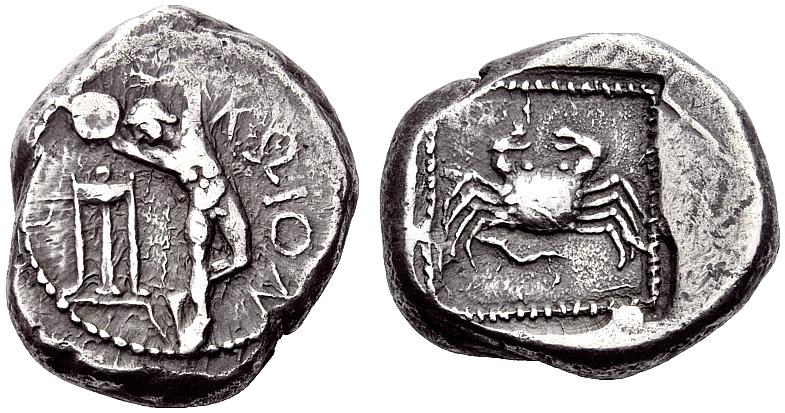SO 1478 - Cos over uncertain mint
From SILVER
Revision as of 11:42, 8 May 2024 by Avrile Bigot--Bastian (talk | contribs)
480 BCE - 475 BCEΚΩΙΟΝ
Images
Overstriking coin

Cos_NAC_627.jpg [1]
Location/history
| Sale(s)Sale(s) ᵖ: | Numismatica Ars Classica 59, 4 Apr. 2011, n°627= Triton 12, 2009, n°328 = Numismatica Ars Classica 2, 1990, n°200 = Leu-M&M 28, May 1974, Kunstfreund n°165 = Schlessinger 13,1935 = Hermitage, n°1336 | |
| Private collection(s)Private collection(s) ᵖ: | W. B. R Montgomery collection ; Gillet collection |
Overstriking coin
Description
| ObverseInscription or printing placed on the obverse.: | ΚΩΙΟΝ (Greek) Discobolus about to hurl disc. In left field, tripod. Border of dot. | ReverseInscription or printing placed on the reverse.: | Crab within incuse square with dotted borders. |
Mint and issuing power
| MintIdentifies the place of manufacture or issue of a numismatic object.: | Cos | Ancient regionAncient region. | Caria | Modern countryModern country: Greece | AuthorityIdentifies the issuing power. The authority can be "pretended" when the name or the portrait of X is on the coin but he/she was not the issuing power. It can also be "uncertain" when there is no mention of X on the coin but he/she was the issuing power according to the historical sources: |
Chronology
| FromIdentifies the initial date in a range assigned in a numismatic context. 480 BCE toIdentifies the final date in a range assigned in a numismatic context.. 475 BCE | Classical 480-323 BC |
Physical description
| MetalThe physical material (usually metal) from which an object is made.: Silver |
WeightWeight of the numismatic object (in grams). in grams: 16.4816.48 g <br />16,480 mg <br /> | DenominationTerm indicating the value of a numismatic object. Examples: tetradrachm, chalkous, denarius.: triple siglos |
|
| StandardStandard.: Persic | |||
References
| Coin referenceReference of the Coin: | Babelon 1910, 1740 and pl. CCCLXVIII 13., Boston 2016, BMC Crete, n°9, Kunstfreund 165 | Coin series referenceReference to coin series study: | BMC Crete1BMC Crete, n°9, Babelon 19102Babelon 1910, Barron 19683Barron 1968, Group B, n°13-18, HGC 64HGC 6, n°1299 |
| Coin series web referenceCoin series web references: | |||
Overstruck type
Description
| ObverseInscription or printing placed on the obverse.: | ReverseInscription or printing placed on the reverse.: |
Mint and issuing power
| MintIdentifies the place of manufacture or issue of a numismatic object. ᵖ: | Ancient regionAncient region. ᵖ | Modern countryModern country: | AuthorityIdentifies the authority in whose name (explicitly or implicitly) a numismatic object was issued. ᵖ: |
Chronology
| FromIdentifies the initial date in a range assigned in a numismatic context. toIdentifies the final date in a range assigned in a numismatic context.. | periodTime period of the numismatic object. |
Physical description
References
| Coin type referenceReference to coin series study ᵖ: |
Additional data
| Frequency of overstrikesFrequency of overstrikes: | Level of confidenceLevel of confidence of the identification: | ||
| RemarksRemarks: | |||
References
- ^ Wroth, Warwick William (1886), A Catalogue of the Greek coins in the British Museum. vol. X : Crete and the Aegean Islands, London, The Trustees, p. 152, pl. XXIX
- ^ Ernest Babelon (1910),"Traité des monnaies grecques et romaines. Tome deuxième, comprenant les monnaies de l'empire des Perses Achemenides, de l'orient semitque et de l'asia mineure, aux Ve et IVe siecles avant J.-C. Deuxième partie, description historique.", Paris, E. Leroux
- ^ Barron, John Penrose (1968), "The Fifth-Century Diskoboloi of Kos", in Colin M. Kraay and Gilbert Kenneth Jenkins (éd.), Essays in Greek Coinage Presented to Stanley Robinson, Oxford, p. 75-89, pl. 8-10.
- ^ Hoover, Oliver D. (2010), The Handbook of Greek Coinage Series, volume 6 : handbook of coins of the islands: Adriatic, Iionian, Thracian, Aegean, and Carpathian seas (excluding Crete and Cyprus), sixth to first centuries BC, Lancaster, 358 p.